 Objective and Key Results are performance tools to measure and focus your teams progress.
Objective and Key Results are performance tools to measure and focus your teams progress.
A focus on just Performance can lead to imbalance.
Pairing Key Results
In Measure What Matters, John Doerr shares this story about Ford and how one-dimensional OKR’s can have disastrous consequences.
The history of the infamous Ford Pinto shows the hazards of one-dimensional OKRs. In 1971, after bleeding market share to more fuel-efficient models from Japan and Germany, Ford countered with the Pinto, a budget-priced subcompact. To meet CEO Lee Iacocca’s aggressive demands, product managers skipped over safety checks in planning and development. For example: The new model’s gas tank was placed six inches in front of a flimsy rear bumper. The Pinto was a firetrap, and Ford’s engineers knew it. But the company’s heavily marketed, metric-driven goals—“under 2,000 pounds and under $2,000”—were enforced by Iacocca “with an iron hand. . . . [W]hen a crash test found that [a] one-pound, one-dollar piece of plastic stopped the puncture of the gas tank, it was thrown out as extra cost and extra weight.” The Pinto’s in-house green book cited three product objectives:
 “True Subcompact” (size, weight); “Low Cost of Ownership” (initial price, fuel consumption, reliability, serviceability); and “Clear Product Superiority” (appearance, comfort, features, ride and handling, performance). Safety was nowhere on the list. Hundreds of people died after Pintos were rear-ended, and thousands more were severely injured. In 1978, Ford paid the price with a recall of 1.5 million Pintos and sister model Mercury Bobcats, the largest in automotive history. The company’s balance sheet and reputation took a justified beating. Looking back, Ford didn’t lack for objectives or key results. But its goal-setting process was fatally flawed: “The specific, challenging goals were met (speed to market, fuel efficiency, and cost) at the expense of other important features that were not specified (safety, ethical behavior, and company reputation).”
“True Subcompact” (size, weight); “Low Cost of Ownership” (initial price, fuel consumption, reliability, serviceability); and “Clear Product Superiority” (appearance, comfort, features, ride and handling, performance). Safety was nowhere on the list. Hundreds of people died after Pintos were rear-ended, and thousands more were severely injured. In 1978, Ford paid the price with a recall of 1.5 million Pintos and sister model Mercury Bobcats, the largest in automotive history. The company’s balance sheet and reputation took a justified beating. Looking back, Ford didn’t lack for objectives or key results. But its goal-setting process was fatally flawed: “The specific, challenging goals were met (speed to market, fuel efficiency, and cost) at the expense of other important features that were not specified (safety, ethical behavior, and company reputation).”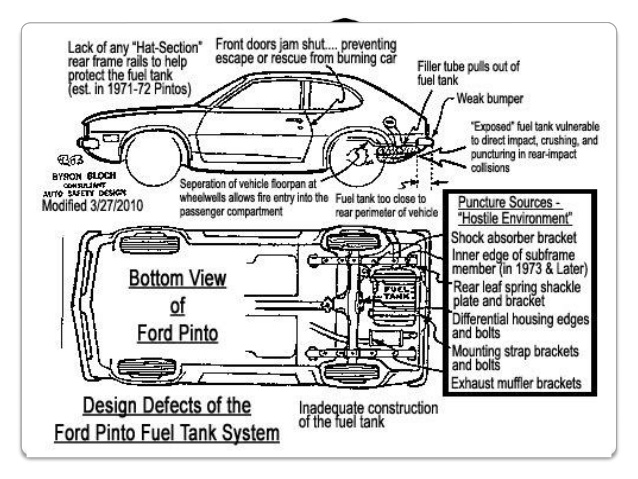
You may think these kind of issues are a thing of the past. Doerr notes another recent cautionary tale. Wells Fargo is still reeling from a consumer banking scandal stemming from ruthless, one-dimensional sales targets. Wells Fargo branch managers felt pressured to open millions of fraudulent accounts customers neither wanted nor needed. In one case, a manager’s teenage daughter had twenty-four accounts, her husband twenty-one. In the fallout, more than five thousand bankers were fired; the company’s credit.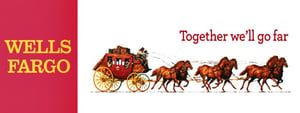
An over emphasis on Performance without a counter balance measure on Quality and People/relationships can produce harmful, even devastating consequences.
For More on Counterbalance Read ;
What’s a Counterbalance – Why Quarter and Annual Plans Need One
Lie # 5 A Balanced Life - The Solution - Counterbalance
WHAT PAIRED RESULTS LOOK LIKE
Here is an example of Key Results paired from Measure What Matters and an online example.
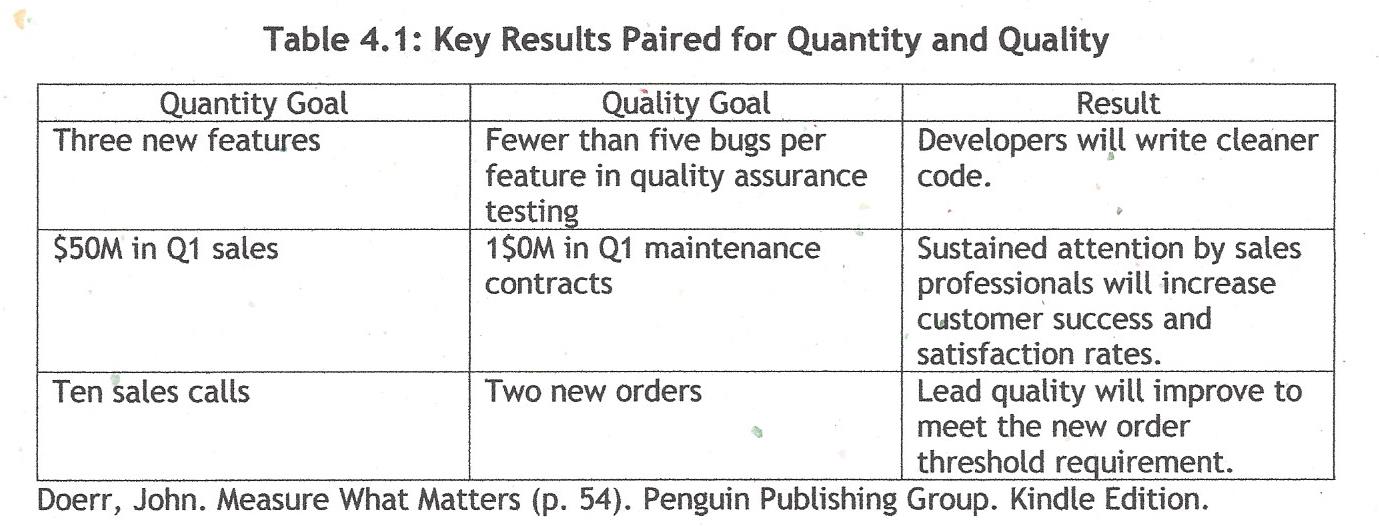 The first column represents a Quantity Goal for your Key Result. The second column is the Paired Result, or Counterbalance. By pairing a Quantity goal with a Quality goal the outcome should be the Result you see in the last column.
The first column represents a Quantity Goal for your Key Result. The second column is the Paired Result, or Counterbalance. By pairing a Quantity goal with a Quality goal the outcome should be the Result you see in the last column.
Finally the last one is a complete OKR. You can see the Objective, and then the four Key Results. Do you see the two quality paired results?
In the first two bullets, manual Intervention on big user issues reduced by 50% is paired with Self-Service Adoption. If you increase self service adoption, while your team is still investing as much time to intervene to solve big issues, than your App isn’t reaching a quality standard.
Third and fourth bullets are also paired. 100,000 downloads are of little value if 80% of the users aren’t happy with their experience.
Has your business started the practice of Objective and Key Results?
Pick up the book, Measure What Matters.
Looking for a coach to help?
Contact dwick@positioningsystems.com for ScaleUp practices, and specifically Strategic Discipline to lay the foundation for an effective OKR platform starting with your leadership team.
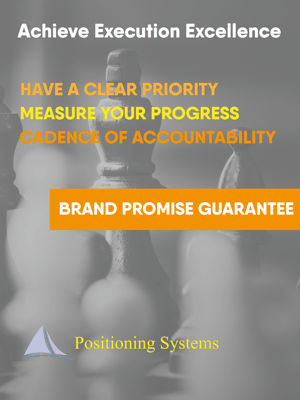 Growth demands Strategic Discipline.
Growth demands Strategic Discipline.
Positioning Systems is obsessively driven to improve your business and your team’s execution. 3 Strategic Disciplines: Priority, Metrics and Meeting Rhythms help your business dramatically improve your forecasting, individual, and team performance creating alignment.
Empower your team to achieve accelerated growth.
As an Execution Decision, Strategic Discipline increases your Profitability.
In Measure What Matters, Doerr’s book shares exactly how Strategic Discipline works. OKR’s are the same pattern of Priority and Metrics, as Objective and Key Results. The Discipline of a Cadence of Accountability (Meeting Rhythms) drives your key outcomes.
Positioning Systems helps your business achieve these outcomes on the Four most Important Decisions your business faces:
|
DECISION |
RESULT/OUTCOME |
|
PEOPLE |
|
|
STRATEGY |
|
|
EXECUTION |
|
|
CASH |
|
We help your business Achieve Execution Excellence.
Positioning Systems helps mid-sized ($5M - $250M) business Scale-UP. We align your business to focus on Your One Thing! To achieve growth, you need to evolve in today’s rapidly changing economic environment. Have you been avoiding a conversation on how you can successfully grow your business? Contact dwick@positioningsystems.com to Scale Up your business! Take our Four Decisions Needs Assessment to discover how your business measures against other Scaled Up companies. We’ll contact you.
Next Blog – Cadence of Accountability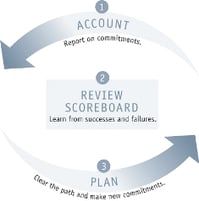
Once you establish OKR’s in your business, there’s an important step to achieve accountability. Strategic Discipline, the Execution Discipline of the Four Decisions, is a formula to increase monitoring, accountability, and the habit of developing metrics for each quarter. We’ll share Meeting Rhythms and the Cadence of Accountability next blog.






.jpeg?width=150&height=135&name=Hand%20with%20marker%20writing%20the%20question%20Whats%20Next_%20(1).jpeg)

